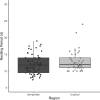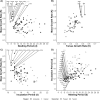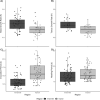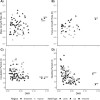Development syndromes in New World temperate and tropical songbirds
- PMID: 32804928
- PMCID: PMC7430732
- DOI: 10.1371/journal.pone.0233627
Development syndromes in New World temperate and tropical songbirds
Abstract
We studied avian development in 49 to 153 species of temperate and tropical New World passerine birds to determine how growth rates, and incubation and nestling periods, varied in relation to other life-history traits. We collected growth data and generated unbiased mass and tarsus growth rate estimates (mass n = 92 species, tarsus n = 49 species), and measured incubation period (n = 151) and nestling period (n = 153), which we analyzed with respect to region, egg mass, adult mass, clutch size, parental care type, nest type, daily nest predation rate (DMR), and nest height. We investigated covariation of life-history and natural-history attributes with the four development traits after controlling for phylogeny. Species in our lowland tropical sample grew 20% (incubation period), 25% (mass growth rate), and 26% (tarsus growth rate) more slowly than in our temperate sample. Nestling period did not vary with respect to latitude, which suggests that tropical songbirds fledge in a less well-developed state than temperate species. Suboscine species typically exhibited slower embryonic and post-embryonic growth than oscine passerines regardless of their breeding region. This pattern of slow development in tropical species could reflect phylogenetic effects based on unknown physiological attributes. Time-dependent nest mortality was unrelated to nestling mass growth rate, tarsus growth rate, and incubation period, but was significantly associated with nestling period. This suggests that nest predation, the predominant cause of nest loss in songbirds, does not exert strong selection on physiologically constrained traits, such as embryonic and post-embryonic growth, among our samples of temperate and lowland tropical songbird species. Nestling period, which is evolutionarily more labile than growth rate, was significantly shorter in birds exposed to higher rates of nest loss and nesting at lower heights, among other traits. Differences in life-history variation across latitudes provide insight into how unique ecological characteristics of each region influence physiological processes of passerines, and thus, how they can shape the evolution of life histories. While development traits clearly vary with respect to latitude, trait distributions overlap broadly. Life-history and natural history associations differ for each development trait, which suggests that unique selective pressures or constraints influence the evolution of each trait.
Conflict of interest statement
The authors have declared that no competing interests exist.
Figures




References
-
- Williams GC. Natural selection, the costs of reproduction, and a refinement of Lack’s principle. Am Nat. 1966;100: 687 10.1086/282461 - DOI
-
- Ricklefs RE, Wikelski M. The physiology/life-history nexus. Trends in Ecology and Evolution. 2002;17: 462–468. 10.1016/S0169-5347(02)02578-8 - DOI
-
- Robinson WD, Hau M, Klasing KC, Wikelski M, Brawn JD, Austin SH, et al. Diversification of life histories in New World birds. Auk. 2010;127: 253–262. 10.1525/auk.2010.127.2.253 - DOI
-
- Ricklefs RE. The nesting cycle of songbirds in tropical and temperate regions. Living Bird. 1969;8: 165–175.
-
- Snow DW, Lill A. Longevity records for some neotropical land birds. Condor. 1974;76: 262–267. 10.2307/1366339 - DOI
Publication types
MeSH terms
LinkOut - more resources
Full Text Sources

